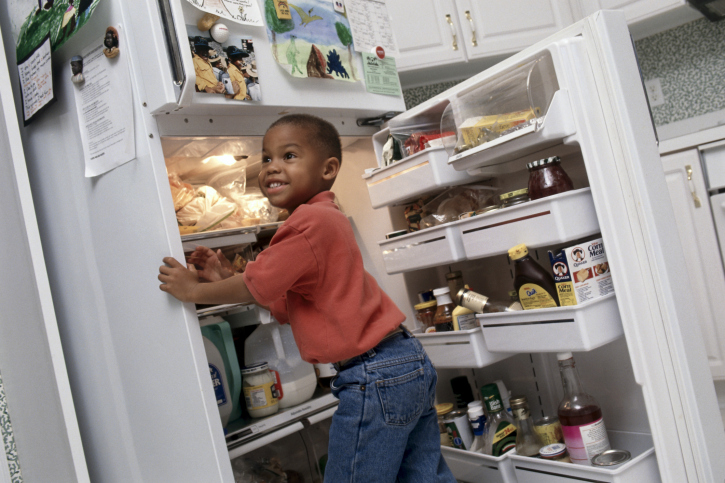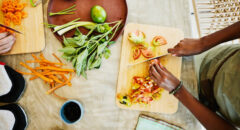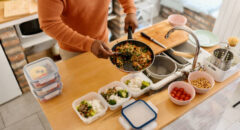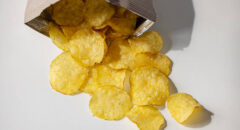 There is an old nutrition adage, “ if a food is in your possession or located in your residence, you will eventually eat it.” Many of us eat unhealthy foods because they are ever present in our kitchens. One way to reduce the risk of eating unhealthy foods is to whip your kitchen into shape by replacing unhealthy foods with healthier choices.
There is an old nutrition adage, “ if a food is in your possession or located in your residence, you will eventually eat it.” Many of us eat unhealthy foods because they are ever present in our kitchens. One way to reduce the risk of eating unhealthy foods is to whip your kitchen into shape by replacing unhealthy foods with healthier choices.
An out-of-shape kitchen would include foods such as:
▪ Potato chips
▪ Soft drinks
▪ Sausage and other fatty meats
▪ “Low-fat” or “reduced-fat” cookies
▪ White bread
▪ White rice
▪ Crackers
▪ Candy
▪ Chocolates
▪ Granola bars
▪ Cake mix
▪ Frozen dinners
▪ Margarine
▪ Baked goods
On the other hand, an in-shape kitchen would include foods such as:
▪ Fruits
▪ Vegetables
▪ Salmon
▪ Skinless chicken breast
▪ Extra-lean beef
▪ Bell peppers
▪ Eggs
▪ Beans
▪ Whole oats
▪ Quinoa
▪ Nuts
▪ Olive or Canola oil
▪ Green tea
▪ Sweet potatoes
5 Tips to Get Your Kitchen in Shape
Does your kitchen mostly contain foods from the in-shape list? Outstanding! Your kitchen is in-shape. Does your kitchen mostly contain foods from the out-of-shape list? Don’t fret. As you shop for groceries, begin to replace the foods from the out-of-shape kitchen list with those from the in-shape kitchen.
According to Harvard Medical School, here are 5 tips to help get your kitchen–and you–in shape!
- Hide snack foods. If you keep your salty or sugary snacks on the kitchen counter, find them a new home tucked away in the pantry. If they’re not in your line of vision every time you enter the kitchen, you’ll be less tempted to eat them. Researchers at Cornell University found that people who stored foods and beverages such as candy, cereal, and soda on their kitchen counters weighed 20 to 26 pounds more than people who kept these items out of sight. On the flip side, those who placed a bowl of fruit on the counter weighed 13 pounds less than people who didn’t.
- Revamp your refrigerator. Arrange the foods that you’d like to eat more of — such as fruits, vegetables, lean meats, eggs, hummus, low-fat milk, cottage cheese, and yogurt — at eye level in your fridge so you’re more likely to grab these first when you’re hungry.
- Make your freezer friendlier. Your freezer can be a lifesaver when there’s no time to shop for healthy food. Because frozen produce is flash-frozen within hours of harvest, it’s often nutritionally superior to fresh, which can sit on store shelves for days, losing nutrients all the while. Stock up on frozen vegetables for quick side dishes you can microwave in minutes. Think of carrots, peas, broccoli, spinach, and edamame — you can even find interesting vegetable mixes, including some stir-fry blends. Any vegetable is fine, as long as it’s free of cheese or buttery sauces.
- Upgrade your pantry. Set aside some time to clean out and restock your pantry with these staples for quick and easy meals:
Quinoa, whole-wheat couscous, brown rice, and whole-wheat pasta. Higher in fiber than white rice or noodles, these whole grains are gradually digested for prolonged energy and satiety.
Canned beans. Whether they’re black beans, pinto beans, or chickpeas, beans are a speedy way to add protein and fiber to salads, soups, and pasta.
Dried red lentils. These offer up the same health benefits as beans, plus they cook in just 15 minutes.
Cold whole-grain cereal and rolled oats. With these, you can make a nutrient-packed breakfast in minutes.
Air-popped or fat-free popcorn. Everyone needs a crunchy snack sometimes. Make yours popcorn. You can eat five cups of air-popped popcorn for the same 150 calories you’d get from just 22 potato chips.
Canned tuna and salmon. These lean proteins are a cinch to toss into salad or pasta on a busy weeknight. Marinara sauce. In addition to mixing with pasta, - Use smaller dishes. Simply using a bowl that’s 50% larger encourages you to eat 20% more food. To keep your portions in check, try replacing 12-inch dinner plates with 10-inch ones. Or else banish your dinner-sized plates to the back of your kitchen cabinets and move salad plates up front so they’ll be the first thing you reach for when you set the table. Take a close look at your bowls and serving dishes. Are they also oversized? If so, replace them with cereal bowls and invest in a few smaller bowls for soup and cereal. For snacks, try a small half-cup bowl or ramekin instead of a regular bowl.
And don’t forget to check out your drinking glasses. Many of these can hold 12 ounces of fluid or more. If you’re using giant glasses for water or a big mug for unsweetened coffee or tea, go ahead and keep these up front. But if you’re trying to cut down on sugary drinks, push large glasses and mugs to the back of the cabinet and move smaller juice-sized glasses and coffee cups to the front.
Get your kitchen in shape and you’ll be on your way to a healthier you!
Visit the BlackDoctor.org Food center for more articles.
 Sloan Luckie, a Certified Personal Trainer and Certified Public Accountant, is the author of the optimal health workbook, Body Under Construction. Body Under Construction shows how to use nutrition, exercise and sleep to attain and maintain optimal health.
Sloan Luckie, a Certified Personal Trainer and Certified Public Accountant, is the author of the optimal health workbook, Body Under Construction. Body Under Construction shows how to use nutrition, exercise and sleep to attain and maintain optimal health.

Sloan’s unique philosophy on building and maintaining optimal health has garnered significant media attention. He has appeared on NBC’s “The Talk” with Marion Brooks, NY1 News with Cheryl Wills, WVON Radio with Kendall Moore, WYCA Radio with TL Richardson and graced the pages of Syd Jerome magazine. He’s conducted wellness demonstrations for women’s heart disease, men’s prostate and childhood obesity awareness seminars. Sloan has also conducted nutrition and fitness demonstrations for corporations and not-for-profit organizations throughout the United States.
Sloan Luckie, who is also the founder of Body Under Construction, LLC.









